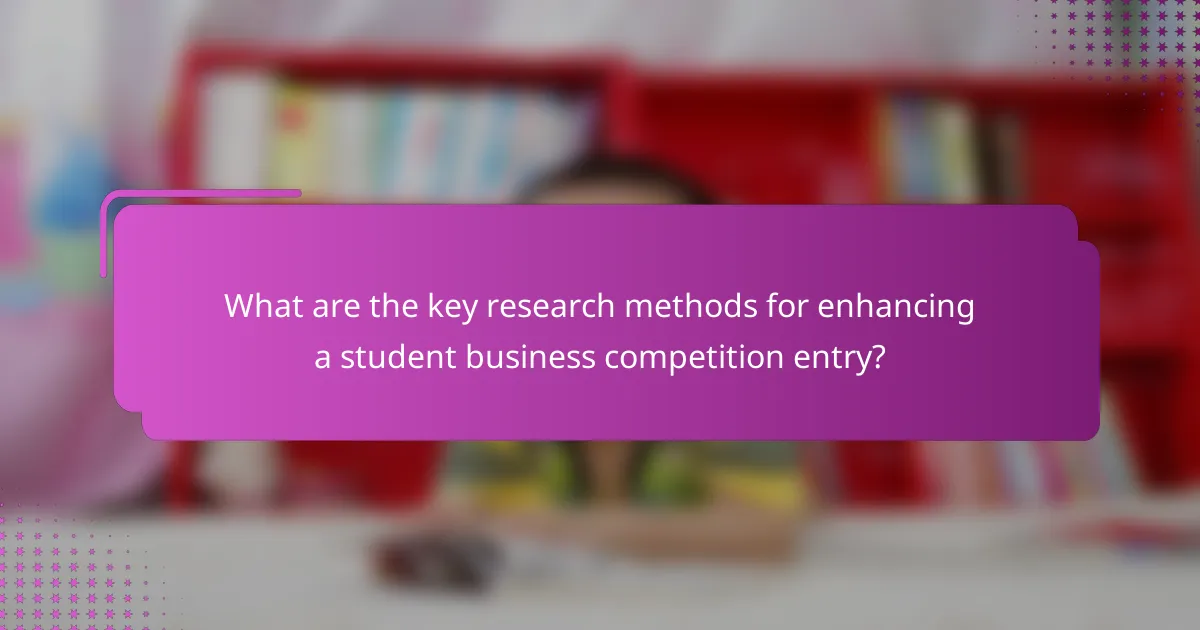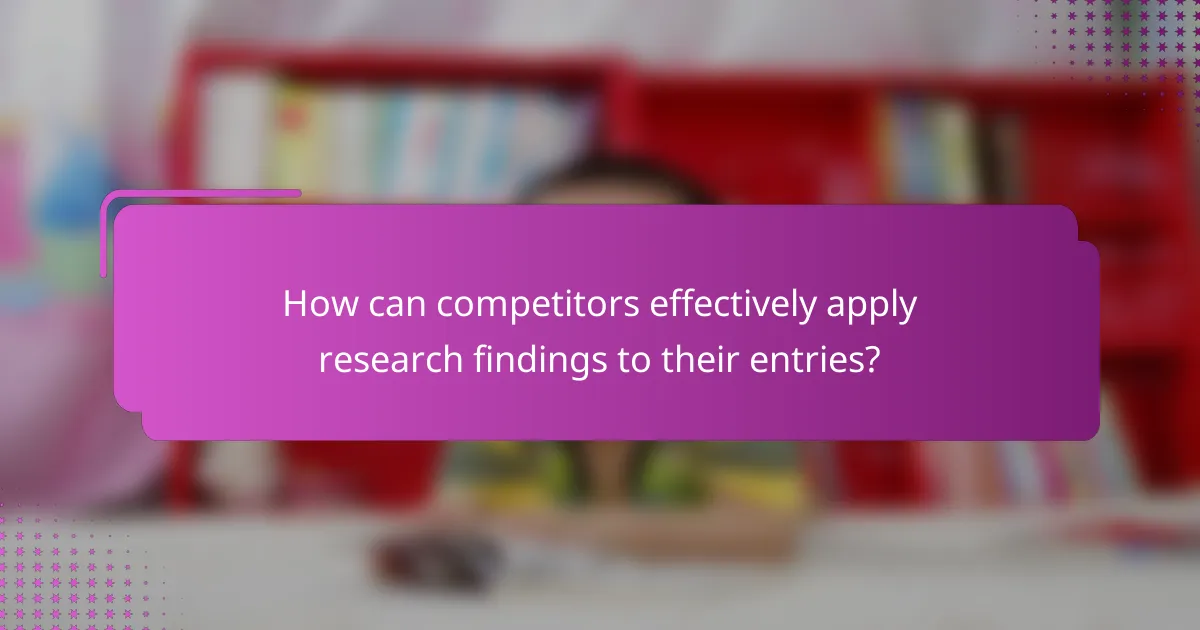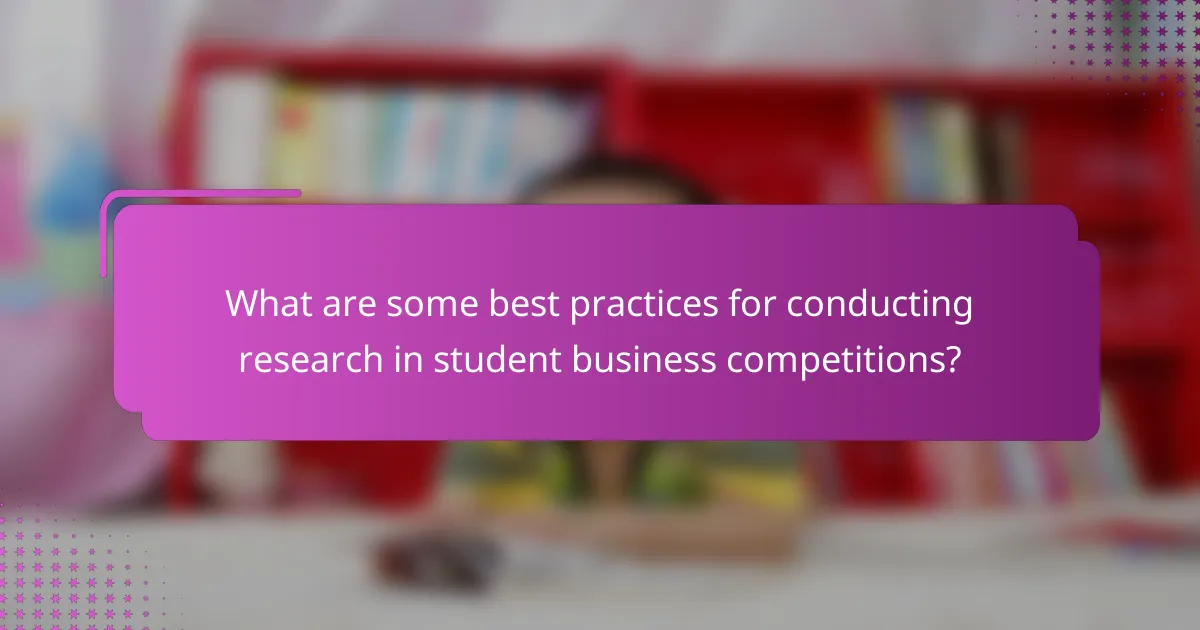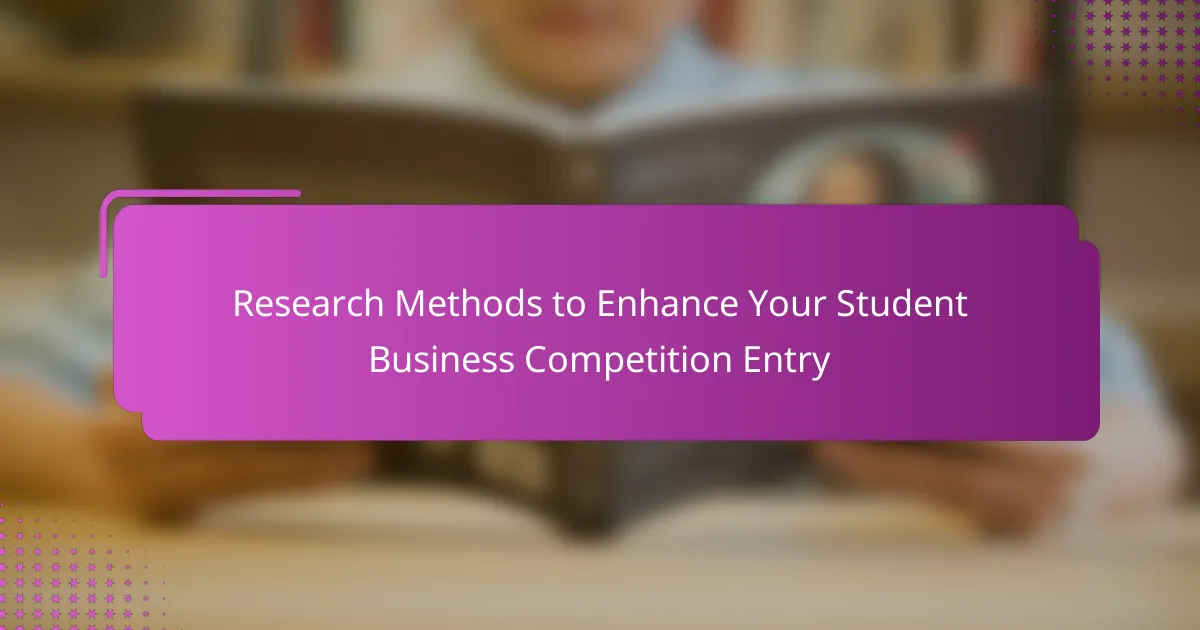The article focuses on research methods that enhance student business competition entries, emphasizing key strategies such as market analysis, competitor analysis, customer surveys, and case studies. It outlines how these methods help identify industry trends, evaluate rival strengths, and gather consumer insights, ultimately improving the quality and viability of competition submissions. Best practices for conducting research include defining clear objectives, utilizing credible sources, and engaging with experienced mentors. The article highlights the importance of data-driven insights in refining business strategies and increasing productivity, providing a comprehensive framework for students to strengthen their competition entries.

What are the key research methods for enhancing a student business competition entry?
Key research methods for enhancing a student business competition entry include market analysis, competitor analysis, and customer surveys. Market analysis helps identify trends and opportunities in the industry. Competitor analysis evaluates the strengths and weaknesses of rival entries. Customer surveys gather insights on preferences and needs. Utilizing case studies provides real-world examples of successful business strategies. Focus groups allow for in-depth discussions about ideas and concepts. Academic research can offer theoretical frameworks to support business models. These methods collectively strengthen the quality and viability of the competition entry.
How do qualitative research methods contribute to competition entries?
Qualitative research methods enhance competition entries by providing in-depth insights into target audiences. These methods include interviews, focus groups, and observations. They help identify the needs, preferences, and behaviors of potential customers. For instance, a study by Creswell (2013) emphasizes that qualitative data can reveal underlying motivations that quantitative data may overlook. This understanding allows participants to tailor their entries to resonate more effectively with judges and audiences. Furthermore, qualitative research can uncover unique selling propositions that differentiate a business idea from competitors. By leveraging these insights, competitors can craft more compelling narratives in their entries.
What are the most effective qualitative techniques for gathering insights?
The most effective qualitative techniques for gathering insights include interviews, focus groups, and ethnographic studies. Interviews allow for in-depth exploration of individual perspectives. They can uncover personal experiences and motivations. Focus groups facilitate discussion among participants. This method reveals shared beliefs and attitudes. Ethnographic studies involve observing participants in their natural environment. This technique provides context to behaviors and interactions. Each of these methods captures rich, nuanced data. They are essential for understanding complex human behaviors.
How can interviews and focus groups be structured for optimal results?
Interviews and focus groups can be structured for optimal results by following a clear framework. First, define the objectives of the session. This ensures that all questions are relevant and targeted. Next, develop a structured guide with open-ended questions. Open-ended questions encourage detailed responses, providing richer data.
Additionally, select a diverse group of participants. Diversity leads to a wider range of perspectives. Establish a comfortable environment to promote open communication. This can be achieved through appropriate seating arrangements and minimizing distractions.
Finally, employ a skilled moderator to facilitate discussion. A skilled moderator can keep the conversation on track and ensure all voices are heard. Research shows that structured methodologies enhance data quality and participant engagement, leading to more insightful outcomes.
What role do quantitative research methods play in business competitions?
Quantitative research methods play a crucial role in business competitions by providing data-driven insights. These methods enable participants to analyze market trends, consumer behavior, and competitive landscapes quantitatively. By applying statistical techniques, competitors can validate their business models and strategies. For instance, surveys and experiments yield measurable data, which can support decision-making. Research shows that teams using quantitative methods often outperform those relying solely on qualitative insights. A study by the Harvard Business Review found that data-driven companies are 5% more productive and 6% more profitable than their competitors. This underscores the importance of quantitative research in enhancing the effectiveness of business competition entries.
What types of quantitative data are most useful for competitors?
Sales figures are the most useful type of quantitative data for competitors. They provide insights into market demand and pricing strategies. Competitors analyze sales data to identify trends and customer preferences. Market share percentages are also critical. They reveal a competitor’s position within the industry. Customer demographics offer valuable information on target audiences. This data helps in tailoring marketing strategies effectively. Additionally, profit margins indicate financial health and operational efficiency. Competitors can benchmark their performance against industry standards using this data. Overall, these quantitative data types enable informed decision-making and strategic planning.
How can surveys and statistical analysis enhance decision-making?
Surveys and statistical analysis enhance decision-making by providing data-driven insights. They collect information on preferences, behaviors, and opinions from target audiences. This data allows organizations to identify trends and patterns. Statistical analysis interprets this data to quantify relationships and predict outcomes. For example, a survey might reveal customer satisfaction levels. Analyzing this data can inform product improvements or marketing strategies. Research shows that data-driven decision-making can improve performance by 5-6%. Effective use of surveys and analysis leads to informed choices that align with audience needs.

How can competitors effectively apply research findings to their entries?
Competitors can effectively apply research findings to their entries by integrating data-driven insights into their strategies. This involves analyzing market trends, understanding consumer behavior, and identifying gaps in the competition. Competitors should utilize qualitative and quantitative research methods to gather relevant information. For instance, surveys can provide direct feedback from potential customers. Additionally, competitor analysis can highlight successful tactics used by others in the industry. By applying these findings, competitors can refine their value propositions and enhance their overall presentation. Research indicates that businesses leveraging data-driven strategies see a 5-6% increase in productivity. This demonstrates the tangible benefits of effectively utilizing research in competition entries.
What strategies can be used to integrate research into business plans?
Conducting market analysis is a key strategy to integrate research into business plans. This involves gathering data on industry trends, customer needs, and competitor activities. Utilizing surveys can provide insights directly from potential customers. Analyzing existing literature helps in understanding best practices and market gaps. Incorporating SWOT analysis allows businesses to assess strengths, weaknesses, opportunities, and threats based on research findings. Engaging with industry experts can provide valuable perspectives and validate assumptions. Using data visualization tools can enhance the presentation of research findings in the business plan. Lastly, continuously updating the business plan with new research ensures relevance and adaptability in a changing market.
How can competitors prioritize research findings for maximum impact?
Competitors can prioritize research findings for maximum impact by categorizing them based on relevance and applicability. They should assess which findings align closely with their strategic goals. Competitors can use frameworks like the Eisenhower Matrix to distinguish between urgent and important findings. This helps in focusing on high-impact insights first. Additionally, competitors should consider the potential return on investment for implementing each finding. Data-driven decision-making can guide this prioritization process. For instance, research by the Harvard Business Review emphasizes the importance of aligning research with business objectives to enhance effectiveness. Prioritizing findings in this manner ensures that resources are allocated efficiently for maximum impact.
What common pitfalls should competitors avoid when applying research?
Competitors should avoid misinterpreting data when applying research. Misinterpretation can lead to incorrect conclusions. This often stems from a lack of understanding of statistical methods. Competitors may also overlook the importance of context in research findings. Ignoring the specific market conditions can skew results. Additionally, relying on outdated or irrelevant data can misguide decision-making. Competitors should also avoid confirmation bias. This bias occurs when individuals only seek information that supports their pre-existing beliefs. Finally, failing to validate sources can result in using unreliable information. Trustworthy data is essential for credible research outcomes.
How can competitors validate their research to strengthen their entries?
Competitors can validate their research by cross-referencing data from multiple credible sources. This includes academic journals, industry reports, and expert interviews. Using triangulation ensures that findings are consistent and reliable. Competitors should also seek peer reviews of their research methodologies and conclusions. Engaging with mentors or industry professionals can provide additional insights and confirmations. Furthermore, conducting surveys or focus groups can help gather firsthand feedback. This feedback can validate assumptions and refine research outcomes. According to a study by Creswell (2014), mixed methods enhance research credibility by integrating qualitative and quantitative data.
What methods can be used to ensure research reliability and validity?
To ensure research reliability and validity, researchers can employ several methods. One method is using standardized instruments, which provide consistent measures across different studies. Another method is conducting pilot studies to test the research design and identify potential issues. Triangulation, which involves using multiple data sources or methods, enhances the credibility of findings. Random sampling helps ensure that the sample represents the population accurately, reducing bias. Additionally, researchers can use statistical analyses to assess reliability, such as calculating Cronbach’s alpha for internal consistency. Peer review of research design and findings can also bolster validity. Finally, maintaining transparency in the research process allows for replication and verification of results.
How can peer reviews and expert feedback enhance research credibility?
Peer reviews and expert feedback enhance research credibility by providing an objective assessment of the research quality. This process involves independent experts evaluating the methodology, findings, and conclusions. It ensures that the research meets established standards and is free from bias. Peer reviews can identify gaps in the research and suggest improvements. This leads to more robust and reliable results. Studies show that peer-reviewed articles are more likely to be cited and trusted in the academic community. According to a 2020 analysis published in “PLOS ONE,” peer-reviewed research is viewed as more credible by scholars and practitioners alike.

What are some best practices for conducting research in student business competitions?
Best practices for conducting research in student business competitions include defining clear objectives. Establish what information is needed for your project. Utilize credible sources such as academic journals and industry reports. Analyze competitors to understand their strengths and weaknesses. Engage with mentors who have experience in business competitions. Collect data through surveys or interviews to gather firsthand insights. Organize the research findings systematically for easy reference. Lastly, continuously review and update your research as new information becomes available. These practices enhance the quality and relevance of your competition entry.
What tips can help streamline the research process?
Organizing research effectively can streamline the research process. Start by defining clear research objectives. This helps in focusing on relevant information. Utilizing a structured outline can guide the research flow. Prioritize credible sources to ensure accuracy. Use digital tools for efficient data collection and management. Establish a timeline to maintain progress and avoid last-minute rushes. Regularly review findings to stay aligned with objectives. Collaboration with peers can provide diverse insights and enhance understanding.
How can time management improve research efficiency?
Time management can significantly improve research efficiency by allowing researchers to allocate specific time slots for various tasks. This structured approach minimizes distractions and enhances focus. By prioritizing tasks, researchers can address the most critical aspects first. Effective time management also prevents procrastination, leading to more consistent progress. Studies show that individuals who use time management techniques report higher productivity levels. For instance, a study by Britton and Tesser (1991) found that students who planned their study time performed better academically. Overall, time management optimizes the research process, resulting in more effective outcomes.
What tools and resources are recommended for effective research?
Recommended tools and resources for effective research include academic databases, library catalogs, and online search engines. Academic databases like JSTOR and Google Scholar provide access to peer-reviewed articles. Library catalogs help locate books and other resources available in physical or digital libraries. Online search engines, such as Google, can yield a broad range of information. Utilizing citation management tools like Zotero or EndNote can streamline organizing references. Additionally, resources like research guides from universities offer structured approaches to specific topics. Collaboration tools like Mendeley facilitate sharing research with peers. Each of these tools enhances the research process by providing access to credible information and efficient organization methods.
What are common challenges in research for business competitions and how can they be overcome?
Common challenges in research for business competitions include limited access to data, lack of time, and insufficient understanding of the market. Limited access to data can hinder the ability to gather relevant information. This can be overcome by utilizing online databases and industry reports. Lack of time often leads to rushed research efforts. Implementing a structured timeline can help manage research phases effectively. Insufficient understanding of the market may result in misguided strategies. Engaging with mentors or industry experts can provide valuable insights. Each of these strategies addresses specific challenges and enhances the quality of research conducted for business competitions.
How can competitors address limited access to data?
Competitors can address limited access to data by utilizing alternative data sources. They can leverage publicly available information, such as government databases and industry reports. Engaging in primary research through surveys and interviews can also provide valuable insights. Collaborating with academic institutions can offer access to proprietary data. Competitors can employ web scraping techniques to gather data from online platforms. Utilizing social media analytics can yield real-time insights into market trends. These methods enhance data availability and improve decision-making capabilities.
What strategies can help in overcoming biases in research?
Employing diverse research teams can help overcome biases in research. Diverse teams bring varied perspectives and experiences, reducing groupthink. Implementing blind data analysis minimizes personal biases affecting results. Utilizing standardized protocols ensures consistency and objectivity in data collection. Regular training on bias awareness for researchers enhances sensitivity to potential biases. Peer review processes introduce additional scrutiny, helping identify biases before publication. These strategies are supported by studies indicating that diversity improves decision-making and reduces errors in research findings.
What actionable steps can be taken to enhance research for competition success?
To enhance research for competition success, focus on systematic data collection and analysis. Identify key competitors and analyze their strengths and weaknesses. Use surveys and interviews to gather insights from potential customers. Leverage online databases and industry reports for market trends. Implement SWOT analysis to evaluate internal and external factors affecting your business. Regularly review and update your research to stay relevant. Collaborate with peers for diverse perspectives and ideas. Utilize tools like Google Trends and social media analytics for real-time data. This approach leads to informed decision-making and strategic advantage in competitions.
How can competitors create a research plan that aligns with their goals?
Competitors can create a research plan that aligns with their goals by clearly defining their objectives. They should identify specific questions they want to answer through research. This ensures that the research remains focused and relevant. Next, competitors must select appropriate research methods. These can include surveys, interviews, or market analysis. Each method should be chosen based on how well it can address the defined objectives.
Competitors also need to establish a timeline for their research activities. A well-structured timeline helps in managing resources effectively. Additionally, they should allocate a budget for the research process. This includes costs related to tools, participant incentives, and data analysis.
Finally, competitors should regularly review and adjust their research plan as needed. This flexibility allows them to adapt to new insights or changing goals. By following these steps, competitors can ensure their research plan is aligned with their strategic objectives.
What are key takeaways for maximizing research impact on business competition entries?
Key takeaways for maximizing research impact on business competition entries include thorough understanding of the competition criteria. Research should align with the specific goals outlined by the competition. Engaging with relevant literature enhances credibility and supports innovative ideas. Data-driven insights are crucial; they provide a solid foundation for arguments. Collaborating with industry experts can offer valuable perspectives and improve the quality of the submission. Tailoring the presentation to highlight unique findings captures judges’ attention. Finally, practicing clear and concise communication ensures that key messages resonate effectively.
Research Methods to Enhance Your Student Business Competition Entry focuses on effective strategies to improve competition submissions through comprehensive research methodologies. Key topics include qualitative methods such as interviews and focus groups, which provide in-depth insights into target audiences, and quantitative methods like surveys and statistical analysis that offer data-driven insights for decision-making. The article emphasizes the importance of integrating research findings into business plans, avoiding common pitfalls, and ensuring research reliability and validity. Best practices for conducting research and actionable steps for maximizing impact on competition entries are also outlined, providing a structured approach for participants to enhance their submissions.
